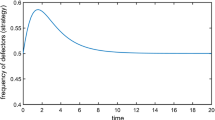Abstract.
Tumour cells have to acquire a number of capabilities if a neoplasm is to become a cancer. One of these key capabilities is increased motility which is needed for invasion of other tissues and metastasis. This paper presents a qualitative mathematical model based on game theory and computer simulations using cellular automata. With this model we study the circumstances under which mutations that confer increased motility to cells can spread through a tumour made of rapidly proliferating cells. The analysis suggests therapies that could help prevent the progression towards malignancy and invasiveness of benign tumours.
Similar content being viewed by others
References
P.C. Nowell, Science, 4260 194, 23 (1976)
D. Hanahan, R. Weinberg, Cell 100, 57 (2000)
M. Mareel, F. Van Roy, The human E-cadherin/catenin complex: a potent invasion and tumor supressor, Verhandelingen – Koninklijke Academie voor Geneeskunde van België 60, 567 (1998)
R.A. Foty, M.S. Steinberg, Int. J. Dev. Biol. 48, 397 (2004)
L. Merlo, J. Pepper, B. Reid, C. Maley, Nat. Rev. Cancer 6, 924 (2006)
R. Gatenby, P. Maini, Nature 421, 321 (2003)
J. von Neumann, O. Morgernstern, Theory of games and economic behaviour (Princeton University Press, Princeton, NJ, 1953)
M. Merston-Gibbons, An introduction to game-theoretic modelling, 2nd edn. (American Mathematical Society, 2000)
J. Maynard Smith, Evolution and the theory of games (Cambridge University Press, Cambridge, 1982)
J. Hofbauer, K. Sigmund, Evolutionary games and population dynamics (Cambridge University Press, Cambridge, 1998)
D. Basanta, A. Deutsch, in Selected topics on cancer modelling: genesis, evolution, inmune competition, therapy, edited by N. Bellomo, M. Chaplain, E. De Angelis (Birkhauser, Boston, 2008)
I.P.M. Tomlinson, Eur. J. Cancer 33, 1495 (1997)
I.P.M. Tomlinson, W.F. Bodmer, Brit. J. Cancer 75, 157 (1997)
L.A. Bach, S.M. Bentzen, J. Alsner, F.B. Christiansen, Eur. J. Cance. 37, 2116 (2001)
L.A. Bach, D.J.T. Sumpter, J. Alsner, V. Loeschke, J. Theor. Med. 5, 47 (2003)
R. Gatenby, T. Vincent, Cancer Res. 63, 6212 (2003)
R. Gatenby, T. Vincent, R. Gillies, Math. Mod. Meth. Appl. S 15, 1619 (2005)
R. Gatenby, T. Vincent, Mol. Cancer Ther. 2, 919 (2007)
Y. Mansury, M. Diggory, T.S. Deisboeck, J. Theo. Biol. 238, 146 (2006)
R. Axelrod, W. Hamilton, Science 211, 1390 (1981)
R. Axelrod, D. Axelrod, K. Pienta, PNAS 103, 13474 (2006)
J. von Neumann, Theory of self-reproducing automata (University of Illinois Press, 1966)
A. Deutsch, S. Dormann, ellular Automaton Modeling of Biological Pattern Formation: Characterization, Applications, and Analysis (Birkhäuser, Boston, 2005)
Mathematical Modeling of Biological Systems, Volume I: Cellular Biophysics, Regulatory Networks, Development, Biomedicine, and Data Analysis, edited by A. Deutsch, L. Brusch, H. Byrne, G. de Vries, H. Herzel (Birkhäuser, Boston, 2008)
J. Moreira, A. Deutsch, Adv. Compl. Sys. 5, 247 (2002)
A.R. Kansal, S. Torquato, E.A. Chiocca, T.S. Deisboeck, J. Theor. Biol. 207, 367 (2000)
B. Ribba, T. Alarcon, K. Marron, P. Maini, Z. Agur, in Proceedings, Cellular Automata: 6th International Conference on Cellular Automata for Research and Industry, ACRI 2004, 2004
M. Wurzel, K.L. Schaller, M. Simon, A. Deutsch, J. Theor. Medic. 6, 21 (2005)
H. Hatzikirou, A. Deutsch, C. Schaller, M. Simon, K. Swanson, Math. Mod. Meth. Appl. Sci. 15, 1779 (2005)
H. Hatzikirou, A Deutsch, Curr. Top. Dev. Biol. 81, 401 (2007)
T. Alarcon, H. M. Byrne, P.K. Maini, J. Theor. Biol. 225, 257 (2003)
R.M.H. Merks, J.A. Glazier, Nonlinearity 19, 1 (2006)
S. Spencer, R. Gerety, K. Pienta, S. Forrest, PLOS Computational Biology 2, 939 (2006)
A. Anderson, A. Weaver, P. Cummings, V. Quaranta, Cell 127, 905 (2006)
A. Giese, M. Loo, N. Tran, S.W. Haskett, M.E. Berens, Int. J. Cance. 67, 275 (1996)
A. Giese, R. Bjerkvig, M.E. Berens, M. Westphal, J. Clin. Oncol. 21, 1624 (2003)
P. Friedl, K. Wolf, Nat. Rev. Cancer. 3, 362 (2003)
Author information
Authors and Affiliations
Corresponding author
Rights and permissions
About this article
Cite this article
Basanta, D., Hatzikirou, H. & Deutsch, A. Studying the emergence of invasiveness in tumours using game theory. Eur. Phys. J. B 63, 393–397 (2008). https://doi.org/10.1140/epjb/e2008-00249-y
Received:
Published:
Issue Date:
DOI: https://doi.org/10.1140/epjb/e2008-00249-y




